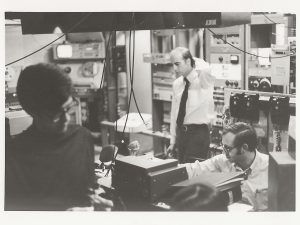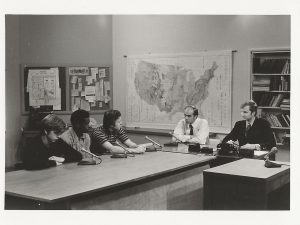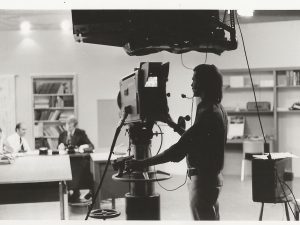Connecticut Public Broadcasting at Trinity College (1962–74)
Anders Yocom ’63
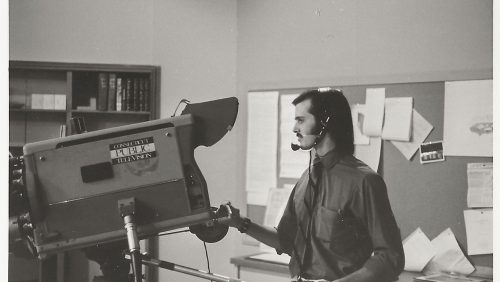
I knew at a very young age that I wanted to pursue a career in broadcasting. When I came to Trinity in the fall of 1959, I immediately joined WRTC and hosted music programs. But imagine my delight when in 1962 as I was entering my senior year, I spotted a posting on a bulletin board. It said that an “educational” television station was being built on campus and was looking for students to work on TV production crews. I think I may have been the first to sign up.
It was the Connecticut Educational Television Corporation, organized by a group of community leaders and supported in part by a grant from the state. We began with a full-time staff of 11 professionals, some of whom had considerable experience in television. Production and broadcast facilities were installed in the basement of the Trinity library. Assigned the call letters WEDH and operating on Channel 24, the station had a transmitter located on one of the mountains west of Hartford.
The small studio was equipped with a lighting grid and a basic control panel. We had two General Electric so-called “image orthicon” black-and-white TV cameras. They were equipped with “rack-over” lenses, and one had a zoom lens that that was operated with a kind of plunger.
The single control room also was equipped with GE facilities that included a device that could televise 16-millimeter film from either of two projectors and stills from 35-millimeter slides. The only equipment that was not GE was our one very early model Ampex videotape recorder. The monster device took up four equipment racks, each about six feet tall and recorded on and played magnetic tape that was two inches wide.
The video control console had to do double duty: broadcast control and production control, sometimes simultaneously. We made it work . . . most of the time.
I was operating one of the cameras for that first broadcast on the morning of October 1, 1962. I was so focused on my camera work that I remember very little about our inaugural program. Whatever it was, I was thrilled to be a part of it.
By 1962, quite a few educational TV stations had gone on the air in cities around the country. In those days, there were no satellites, and we were not connected to a live network. However, we did broadcast programs from New York-based NET (National Educational Television) and from other sources. These programs were “bicycled” on 16-millimeter film or two-inch tape through the mail from station to station, not a reliable way to distribute timely television programs.
From the beginning, our local priority was the production and broadcast of programs to be used in schools. We kept our studio quite busy with programs on Connecticut nature and social studies, many of them featuring the director of The Children’s Museum in West Hartford, who would bring artifacts from the museum to be shown on her many in-school programs.
Another priority was local programming for evening adult viewers about our Connecticut communities. This required us to get out of the studio and into the institutions and neighborhoods where life was happening. We purchased an Auricon 16-millimeter film with sound camera, a bulky device that had many limitations. But it was a start, and I was assigned to learn how to operate it, run the film out to a Hartford suburb for processing, and then edit it for whatever program we were working on.
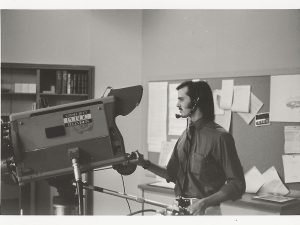
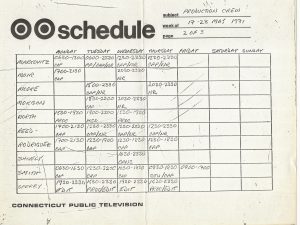
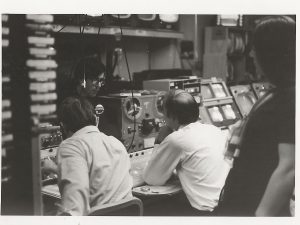
Before long, Trinity College made Boardman Hall available to the growing television operation. The studio was much larger, and we had more space to do our work. At about this time, we also secured funding for a three-camera remote truck that enabled us to provide live or recorded coverage of various civic and cultural events anywhere in the state.
Another development gave us the capability to reach most of Connecticut as new transmitters went on the air in Norwich and Bridgeport and later in New Haven and Waterbury. With this new reach of our signals and the remote production capability, we made the most of it with our pioneering coverage of floor debate, votes, and analysis from the state legislature.
Meanwhile, Congress passed the Public Broadcasting Act of 1967 that funded the Corporation for Public Broadcasting (CPB) which in turn funded the establishment of the Public Broadcasting Service (PBS) and provided community service grants to what would now be called “public” television and radio stations. We were now Connecticut Public Television (CPTV).
At last we were connected to a live feed of the national program schedule offered by PBS. We also had the option to present our Connecticut productions or programs from other sources in prime time or anytime.
By the late ’60s, funds were raised to construct a new CPTV production and headquarters building along New Britain Avenue on the south end of the Trinity campus. The building included a large studio with state-of-the-art lighting, a fully equipped production control room, master control/tape room, scene dock, and office space for administrative and production staff. Color cameras and associated equipment soon were added to our new, modern TV station.
We were still doing remotes and active in reporting on public events in Connecticut, and my proudest program was when we teamed up with The Hartford Courant for coverage of the state’s first primary election in August 1970. Our coverage received a rave review the following Sunday in The New York Times.
When the possibility to work on national programming at PBS came up, I could not resist the opportunity. With some regret, I left CPTV at the end of 1974. After I left, the public radio service was initiated, and the building was expanded. An astounding programming success came with coverage of UConn women’s basketball and the national children’s program Barney & Friends.
In 2004, CPTV and radio left the Trinity campus and moved across town to Asylum Avenue.
